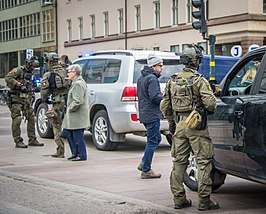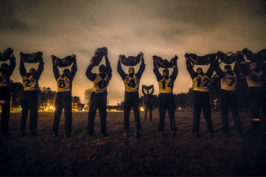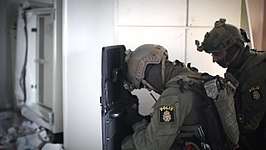National Task Force
| National Task Force | |
|---|---|
| Active | 1991–present |
| Country |
|
| Allegiance | Swedish Police Authority |
| Branch | National Operations Department |
| Type | Counter-terrorism unit |
| Role | Domestic Counter-Terrorism and Law Enforcement |
| Size | ≈ 60 |
| Motto(s) | "Posse Ante Factum Audere Cum Convenit" |
| Engagements |
Various hostage operations Capture of Mijailo Mijailović and several suspect terrorists |
| Commanders | |
| Current commander | Marie Jarnérus[1] |
The National Task Force (Swedish: Nationella insatsstyrkan, NI), formerly known as the National Task Force of the Swedish Civilian Police (Swedish: Ordningspolisens nationella insatsstyrka), is a special operations unit within the National Operations Department of the Swedish Police Authority. It is meant to handle extraordinarily difficult or life-threatening criminal situations, such as terrorism, hostage situations, armed kidnapping and serving high risk arrest warrants in cities too remote for Piketen in Stockholm, Gothenburg and Malmö to handle. It also deals with emergency rescue situations that would be too dangerous or difficult for other police units or emergency services.
The tasks performed between Piketen and the NTF often blur since their duties are similar.[2]

History
After the assassination of Prime Minister Olof Palme in 1986, two state commissions were appointed that looked over Sweden counter-terrorism capabilities. As a result, the government gave the task to the Swedish National Police Board to organize the "Standby Force Against Terrorism" (Beredskapsstyrkan mot terrorism) within the Stockholm County Police Authority in 1990.[3] The group was soon renamed Nationella insatsstyrkan and became also a resource for the whole of Sweden. The right to make decisions about when they were used was delegated by the government to the Swedish National Police Board.[3] After a parliamentary decision in 2002, Nationella insatsstyrkan was transferred from the Stockholm County Police Authority to the National Criminal Police (Rikskriminalpolisen). In connection with the reorganization of the police in 2015, Nationella insatsstyrkan was placed under the National Operations Department.[3]
Organization

The NTF has one head of the unit (currently Marie Jarnérus[1]) with a number of subordinated coordinators, and a staff of older, distinguished police officers. Under this management group the force is divided into 8 groups:
Selection

To be eligible for service with the NTF, the applicant is required to have completed the two and a half year long police training, have a clean criminal record, and be able to pass a series of tests:
- Physical stamina
- Marksmanship
- Non-predisposition for several types of phobias, such as fear of cramped spaces, heights or water
- Psychological fitness
- Deep interview
- Ten days in the field
Operators are recruited based on the units demands, and after the series of tests an average of 6-10% of the candidates succeed and progress to the 6 months of operator training.
Service

Members of the NTF work full-time in the force. They used to work two weeks and then have two weeks of regular police work, but as the need for them increased they changed it to full-time to cope with the demand and the need for more training. Part of their training is done with the Swedish Armed Forces. Several of the members are former members of elite military units, and the National Task Force is described by some as a paramilitary unit within the Swedish police force.
The NTF often train with the special forces unit of the Armed Forces, the Special Operations Task Group.
Armament
The NTF have access to a wide variety of weapons including submachine guns (MP5), assault rifles such as the G36 and the LWRC M6[4][5] as well as shotguns. In addition, all operators use the SIG Sauer P226 pistol as sidearm, which is the standard sidearm used by all Swedish police officers. Snipers are equipped with the L96A1 AW sniper rifle (Swedish military designation: PSG90), HK417, and according to pictures taken during US President Barack Obama's visit to Stockholm in September 2013, the new Sako TRG M10 Sniper Weapon System in caliber .338 Lapua Magnum.[6] The special equipment of the NTF is significantly different from that of the ordinary police. Their equipment, such as communication radios suitable for diving and special ceramic bullet resistant vests, is specific to the situations they would be called upon for. They also distinguish themselves from other Swedish police by a wide variety of uniforms, including woodland camouflage.
Heads
Similar units
-
 Germany – GSG 9
Germany – GSG 9 -
 France – RAID
France – RAID -
 United States – FBI Hostage Rescue Team
United States – FBI Hostage Rescue Team -
 Denmark – AKS
Denmark – AKS -
 Norway – Emergency Response Unit
Norway – Emergency Response Unit -
 United Kingdom – SCO19
United Kingdom – SCO19
See also
References
- 1 2 Dujmovic, Robert (9 March 2016). "Marie leder de hårdaste poliserna". Sydsvenskan (in Swedish). Retrieved 10 April 2017.
- ↑ Schoultz, Eva (2013-06-28). "Gränsen mellan piketen och Nationella Insatsstyrkan granskas". Polistidningen: organ för Svenska polisförbundet (in Swedish). Stockholm: Svenska polisförbundet. LIBRIS 3679459. Retrieved 10 April 2017.
- 1 2 3 "Nationella insatsstyrkan" [National Task Force] (in Swedish). Swedish Police Authority. 2016-10-06. Retrieved 10 April 2017.
- ↑ http://www.thefirearmblog.com/blog/2017/04/21/lwrci-swedish-police/
- ↑ http://www.thefirearmblog.com/blog/2017/04/12/lwrc-ic-a5s-now-use-swedish-le/
- ↑ "Instagram post by Lars Jonsson 🇸🇪 • Nov 30, 2014 at 2:05pm UTC". Instagram. Retrieved 2017-04-03.
- 1 2 Bark, Susanne (3 June 2010). "DI Weekend: Med livet som insats". Dagens Industri (in Swedish). Retrieved 10 April 2017.